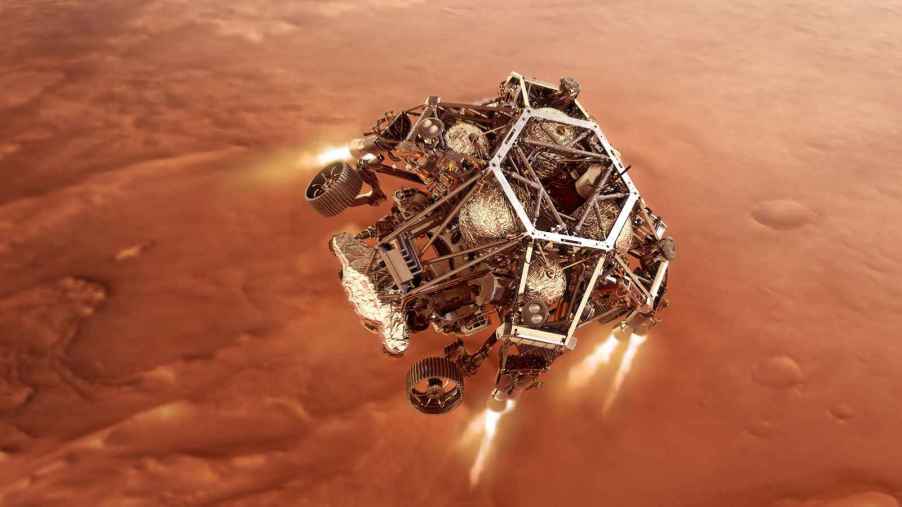
New NASA data further challenges Elon Musk’s bold Mars goal for 2044
“There’s high urgency to making life multi-planetary,” Elon Musk recently told The New York Times. “We’ve got to do it while civilization is so strong.” What’s more, this year, Musk reportedly told SpaceX staffers to start a deep-focused design for a Martian city. However, NASA’s equipment stationed on Mars is constantly delivering new data that has scientists and experts near-fuming at Musk’s “delusional” assumption that a million people could be living on Earth’s inhospitably frozen neighbor within 20 years.
NASA finally found liquid water on Mars. It’s “impossible” for us to reach, though
NASA scientists explore and study Mars via information and images collected by orbiters, landers, and rovers. To date, the equipment has proved, through captured photos and onboard lab testing, that Mars was once full of “National park-quality” landscapes.
Due to only theorized reasoning, the planet dried up and lost its magnetic field some four billion years ago. NASA scientists have worked for years to explain what happened to all the surface water on Mars. Finally, using seismic sensor data retrieved from the inactive Insight lander, we now know where enough water to coat the planet’s surface a mile deep (well, ain’t that a scary image…) is held: about seven to 12 miles below its outer crust.
Unfortunately, if humans somehow gained access to liquid water this deep, the planet’s atmosphere wouldn’t support it just “hanging out” on the surface.
Humans would have to live in airtight “hamster cages” and wear spacesuits outside
Fast-forward from those picturesque mountains, valleys, lakes, and rivers to now, and Mars is nothing short of hellishly hostile to humans. Its thinned atmosphere doesn’t just inhibit natural water systems. It makes Mars highly susceptible to meteoroid, asteroid, and comet collisions.
It’s cold, with highs around 70 degrees Fahrenheit and lows -225 degrees below zero. Dust storms create clouds that take months to settle. Due to the absence of an ozone layer, unsuited humans could quickly die from radiation exposure.
Another main issue is water…or the lack of it on the surface in any significant quantity.
To put it bluntly, Mars is downright inhospitable.
Time will tell how close to Mars humans can actually get
Logistically, even non-human equipment takes a long time to travel. With the latest tech, NASA is working on an arrival flight lasting about nine months. To return, astronauts would need to wait for Earth and Mars to align so that the trip back is as efficient as possible. Even so, it’s a nearly two-year journey. NASA says shorter timelines, closer to 1.5 years, are possible with more powerful spacecraft.
NASA’s Chronology of Mars Exploration shows that in 24 years, the group launched and landed only six unmanned scientific tools on Mars. During a keynote address in the fall of 2023, Elon Musk claimed that Starship, SpaceX’s fully reusable interplanetary transportation system that’s still in testing, will land on Mars within three to four years. This would, theoretically, be an uncrewed flight.
In that address, Musk insisted that the Starship’s size directly reflects SpaceX’s intention to build a manned base on the Moon and a city on Mars. The Starship can hold up to 100 passengers.
In the past, the Tesla CEO and SpaceX founder has also said that he wants to “Die on Mars, just not on impact.” However, back in 2018, he told a podcaster that he would stop making such “jokes.”
One million Mars residents by 2044 could prove to be a “dangerous illusion”
Since then, Musk hasn’t been shy to admit the inherent dangers of a human-occupied Mars. In 2021, CNN indirectly quoted Musk explaining, “There’s a good chance you’ll die on an early SpaceX mission to Mars.” He emphasized that any crewed mission to the Red Planet would be totally voluntary. He likened Starship recruiting to Ernest Shackleton, the legendary explorer trapped with his ship’s crew in the Antarctic in the early 1900s.
The difference here is that Shackleton was on Planet Earth.
Today, anyhow, while NASA’s formal Mars exploration goals do include examining possible human landings, the group is extremely conservative about it. NASA estimates a crewed landing “as soon as the 2030s.”
At this rate, 2044 seems ridiculous. One astronomer called Musk’s claims “a dangerous illusion.”
No doubt, as Earth continues to host billionaires privatizing exploration and travel, more folks with ceilingless resources (and perhaps egos) will be sure to tire of Everest, the Titanic, and building flying cars and set their sights on space. The hope would be that the end goal isn’t so privileged in scope and keeps a keen eye on all of humanity and the planet we call “home” now.



